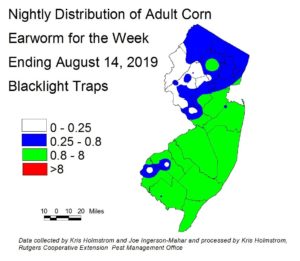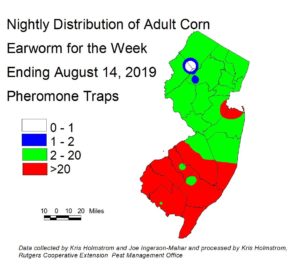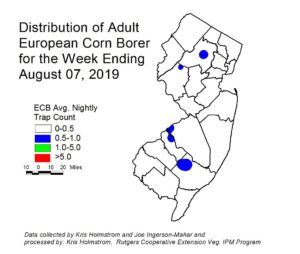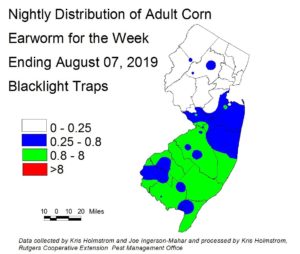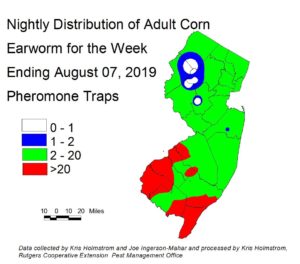Sweet Corn
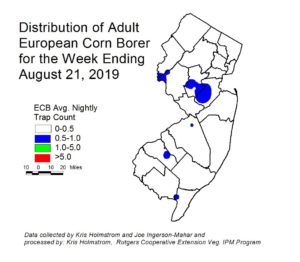 European corn borer (ECB) moth captures have increased in some areas over the past week (see map at left), although catches are very inconsistent. Late summer activity is overall low and scattered. Minor feeding has appeared in whorl and pre-tassel corn, but rarely rises to the 12% threshold by itself. In combination with fall armyworm (FAW) feeding, action thresholds have been exceeded in all areas of the state.
European corn borer (ECB) moth captures have increased in some areas over the past week (see map at left), although catches are very inconsistent. Late summer activity is overall low and scattered. Minor feeding has appeared in whorl and pre-tassel corn, but rarely rises to the 12% threshold by itself. In combination with fall armyworm (FAW) feeding, action thresholds have been exceeded in all areas of the state.
Growers should continue to scout whorl and pre-tassel stage plantings weekly and consider treating when infested plants exceed 12% in a 50 plant sample. As plantings proceed to the pre-tassel stage, ECB larvae may be found in emerging tassels. It is a good idea to treat individual plantings as they move into the full tassel/first silk stage one time. This eliminates any ECB larvae that have emerged with the tassels as they begin to move down the stalk to re-enter near developing ears.
Useful insecticides for this particular application include synthetic pyrethroids (IRAC Grp 3), spinosyns (including OMRI approved Entrust) IRAC Grp 5), and diamides such as Coragen (IRAC Grp 28) or materials such as Besiege which include the active ingredient in Coragen. Synthetic pyrethroids alone should NOT be used for corn earworm (CEW) protection on silking corn. Control with these materials is very inconsistent.
The highest nightly black light trap catches of ECB for the week ending 8/21/19 are as follows:
| Downer 2 | Clinton 1 | Elm 1 | Milford 1 |
| Asbury 1 | Dayton 1 | Hillsborough 1 | Milltown 1 |
| Califon 1 | Eldora 1 | Jobstown 1 | Sergeantsville 1 |
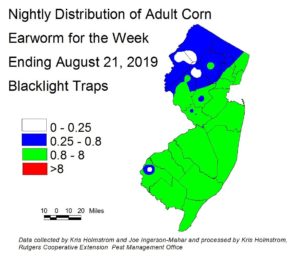 Corn earworm (CEW) moth catches have remained fairly steady over the past week in both trap types. Overall, CEW numbers are moderately high, but not unusual for this time of year. There continue to be some very high catches in southern NJ pheromone traps this past week (see blacklight map at left, and pheromone trap map below at right). There are now economically important populations of this pest throughout the state, and most areas are at extreme risk of crop injury if strict silk spray schedules are not observed. Red areas on the on the pheromone trap map indicate a 3-day silk
Corn earworm (CEW) moth catches have remained fairly steady over the past week in both trap types. Overall, CEW numbers are moderately high, but not unusual for this time of year. There continue to be some very high catches in southern NJ pheromone traps this past week (see blacklight map at left, and pheromone trap map below at right). There are now economically important populations of this pest throughout the state, and most areas are at extreme risk of crop injury if strict silk spray schedules are not observed. Red areas on the on the pheromone trap map indicate a 3-day silk 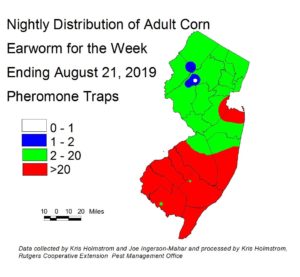 spray schedule, while green indicates a 4-5 day silk spray schedule. Blue areas represent a 5-6 day schedule, and white areas are 6-7 day. There are far fewer CEW pheromone traps than blacklights, and the resulting map has much broader color bands as a result. It should also be noted that the pheromone traps are much more sensitive than blacklights. Therefore, the number of moths caught in pheromone traps required to generate a specific spray interval is much higher than the number caught in blacklight traps. It must be stressed that there is high variability in these catches, and growers should consult with their IPM practitioner on recommended spray schedules.
spray schedule, while green indicates a 4-5 day silk spray schedule. Blue areas represent a 5-6 day schedule, and white areas are 6-7 day. There are far fewer CEW pheromone traps than blacklights, and the resulting map has much broader color bands as a result. It should also be noted that the pheromone traps are much more sensitive than blacklights. Therefore, the number of moths caught in pheromone traps required to generate a specific spray interval is much higher than the number caught in blacklight traps. It must be stressed that there is high variability in these catches, and growers should consult with their IPM practitioner on recommended spray schedules.


